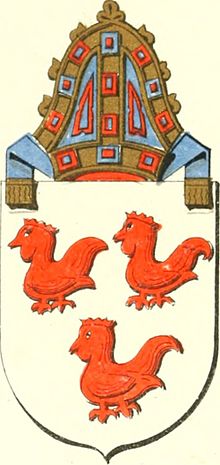Robert Cockburn | |
|---|---|
| Bishop of Dunkeld | |
 Coat of arms of Robert Cockburn | |
| Church | Roman Catholic Church |
| See | Diocese of Dunkeld |
| In office | 1524–1526 |
| Predecessor | Gavin Douglas |
| Successor | George Crichton |
| Previous post(s) | Bishop of Ross (1507–1524) Parson of Dunbar |
| Orders | |
| Consecration | Translated from Ross 27 April 1514 |
| Personal details | |
| Born | 15th century |
| Died | Dunkeld (?), 1526 |
Robert Cockburn (died 1526) was a 16th-century Scottish diplomat and cleric.
Robert Cockburn was the third son of William Cockburn of Skirling and Cessford, and Marion, daughter of Lord Crichton of Sanquhar.[1]
Cockburn was a university graduate, and appears for the first time in 1501 when he was presented to James IV of Scotland for the position of parson of Dunbar, being styled "Master Robert Cockburn, dean of Rouen".[2] Cockburn was later praised for his skill in the Latin language.[3]
He became Bishop of Ross in 1507, by which time he was holding the position of Chancellor of the diocese of Dunkeld.[4] He had received crown nomination to the bishopric on either March or May, and was provided to the see on 9 July.[5] Cockburn was a chaplain to Louis XII of France and acted as a diplomat for James IV of Scotland. On 10 July 1507, Louis asked Cockburn to request 4,000 Scottish troops to assist in the defence of the French possession, the Duchy of Milan. In October James replied that he would send military support if warned in advance, and Cockburn was instructed to discuss another project. This was probably the Scottish king's plans for a crusade. Cockburn carried similar messages in 1512, in the crisis that culminated for Scotland in the Battle of Flodden[6]
Robert spent most of 1515 in France as an ambassador for the government of King James V of Scotland (still a minor).[2] In May 1517 he was sent to France with Patrick Paniter to re-negotiate the Auld Alliance. This negotiation lead to Treaty of Rouen.[7] In 1524, he was in England as one of three ambassadors sent by the Scottish government to agree a truce.[3] It was in that year, on 27 April, that Robert was translated to the bishopric of Dunkeld.[8]
Robert became friends with Cardinal Wolsey, and wrote to him in February 1525 describing the political situation in Scotland. Regent Albany, having left Scotland for France, was still influential and his Dunbar Castle strongly fortified, while Cockburn's ride to England had brought him enemies. In May he addressed a short note to the English ambassador Dr Thomas Magnus, as "my hertly gud frend and broder."[9]
He was Bishop of Dunkeld for only two years, dying on 12 April 1526.[10] He was buried in the choir of Dunkeld Cathedral.[3]
- ^ Cockburn-Hood, Thomas H., The House of Cockburn of that Ilk, Edinburgh (1888), p. 228
- ^ a b Dowden, Bishops of Scotland, p. 224.
- ^ a b c Dowden, Bishops of Scotland, p. 86.
- ^ Watt, Fasti Ecclesiae, pp. 112, 269
- ^ Dowden, Bishops of Scotland, p. 224; Watt, Fasti Ecclesiae, p. 269
- ^ The Letters of James IV, SHS (1953), xliii-xliv, no. 140
- ^ Wood, Marguerite, ed., Flodden Papers, SHS (1933), pp. 123–140.
- ^ Watt, Fasti Ecclesiae, pp. 99, 269.
- ^ Letters & Papers Henry VIII, vol.4 (1875), no.1129, 1313
- ^ Dowden, Bishops of Scotland, p. 224; Watt, Fasti Ecclesiae, p. 99